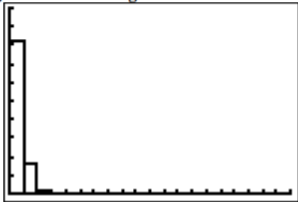5.3: Mean and Standard Deviation of Binomial Distribution
- Page ID
- 5187
\( \newcommand{\vecs}[1]{\overset { \scriptstyle \rightharpoonup} {\mathbf{#1}} } \)
\( \newcommand{\vecd}[1]{\overset{-\!-\!\rightharpoonup}{\vphantom{a}\smash {#1}}} \)
\( \newcommand{\id}{\mathrm{id}}\) \( \newcommand{\Span}{\mathrm{span}}\)
( \newcommand{\kernel}{\mathrm{null}\,}\) \( \newcommand{\range}{\mathrm{range}\,}\)
\( \newcommand{\RealPart}{\mathrm{Re}}\) \( \newcommand{\ImaginaryPart}{\mathrm{Im}}\)
\( \newcommand{\Argument}{\mathrm{Arg}}\) \( \newcommand{\norm}[1]{\| #1 \|}\)
\( \newcommand{\inner}[2]{\langle #1, #2 \rangle}\)
\( \newcommand{\Span}{\mathrm{span}}\)
\( \newcommand{\id}{\mathrm{id}}\)
\( \newcommand{\Span}{\mathrm{span}}\)
\( \newcommand{\kernel}{\mathrm{null}\,}\)
\( \newcommand{\range}{\mathrm{range}\,}\)
\( \newcommand{\RealPart}{\mathrm{Re}}\)
\( \newcommand{\ImaginaryPart}{\mathrm{Im}}\)
\( \newcommand{\Argument}{\mathrm{Arg}}\)
\( \newcommand{\norm}[1]{\| #1 \|}\)
\( \newcommand{\inner}[2]{\langle #1, #2 \rangle}\)
\( \newcommand{\Span}{\mathrm{span}}\) \( \newcommand{\AA}{\unicode[.8,0]{x212B}}\)
\( \newcommand{\vectorA}[1]{\vec{#1}} % arrow\)
\( \newcommand{\vectorAt}[1]{\vec{\text{#1}}} % arrow\)
\( \newcommand{\vectorB}[1]{\overset { \scriptstyle \rightharpoonup} {\mathbf{#1}} } \)
\( \newcommand{\vectorC}[1]{\textbf{#1}} \)
\( \newcommand{\vectorD}[1]{\overrightarrow{#1}} \)
\( \newcommand{\vectorDt}[1]{\overrightarrow{\text{#1}}} \)
\( \newcommand{\vectE}[1]{\overset{-\!-\!\rightharpoonup}{\vphantom{a}\smash{\mathbf {#1}}}} \)
\( \newcommand{\vecs}[1]{\overset { \scriptstyle \rightharpoonup} {\mathbf{#1}} } \)
\( \newcommand{\vecd}[1]{\overset{-\!-\!\rightharpoonup}{\vphantom{a}\smash {#1}}} \)
\(\newcommand{\avec}{\mathbf a}\) \(\newcommand{\bvec}{\mathbf b}\) \(\newcommand{\cvec}{\mathbf c}\) \(\newcommand{\dvec}{\mathbf d}\) \(\newcommand{\dtil}{\widetilde{\mathbf d}}\) \(\newcommand{\evec}{\mathbf e}\) \(\newcommand{\fvec}{\mathbf f}\) \(\newcommand{\nvec}{\mathbf n}\) \(\newcommand{\pvec}{\mathbf p}\) \(\newcommand{\qvec}{\mathbf q}\) \(\newcommand{\svec}{\mathbf s}\) \(\newcommand{\tvec}{\mathbf t}\) \(\newcommand{\uvec}{\mathbf u}\) \(\newcommand{\vvec}{\mathbf v}\) \(\newcommand{\wvec}{\mathbf w}\) \(\newcommand{\xvec}{\mathbf x}\) \(\newcommand{\yvec}{\mathbf y}\) \(\newcommand{\zvec}{\mathbf z}\) \(\newcommand{\rvec}{\mathbf r}\) \(\newcommand{\mvec}{\mathbf m}\) \(\newcommand{\zerovec}{\mathbf 0}\) \(\newcommand{\onevec}{\mathbf 1}\) \(\newcommand{\real}{\mathbb R}\) \(\newcommand{\twovec}[2]{\left[\begin{array}{r}#1 \\ #2 \end{array}\right]}\) \(\newcommand{\ctwovec}[2]{\left[\begin{array}{c}#1 \\ #2 \end{array}\right]}\) \(\newcommand{\threevec}[3]{\left[\begin{array}{r}#1 \\ #2 \\ #3 \end{array}\right]}\) \(\newcommand{\cthreevec}[3]{\left[\begin{array}{c}#1 \\ #2 \\ #3 \end{array}\right]}\) \(\newcommand{\fourvec}[4]{\left[\begin{array}{r}#1 \\ #2 \\ #3 \\ #4 \end{array}\right]}\) \(\newcommand{\cfourvec}[4]{\left[\begin{array}{c}#1 \\ #2 \\ #3 \\ #4 \end{array}\right]}\) \(\newcommand{\fivevec}[5]{\left[\begin{array}{r}#1 \\ #2 \\ #3 \\ #4 \\ #5 \\ \end{array}\right]}\) \(\newcommand{\cfivevec}[5]{\left[\begin{array}{c}#1 \\ #2 \\ #3 \\ #4 \\ #5 \\ \end{array}\right]}\) \(\newcommand{\mattwo}[4]{\left[\begin{array}{rr}#1 \amp #2 \\ #3 \amp #4 \\ \end{array}\right]}\) \(\newcommand{\laspan}[1]{\text{Span}\{#1\}}\) \(\newcommand{\bcal}{\cal B}\) \(\newcommand{\ccal}{\cal C}\) \(\newcommand{\scal}{\cal S}\) \(\newcommand{\wcal}{\cal W}\) \(\newcommand{\ecal}{\cal E}\) \(\newcommand{\coords}[2]{\left\{#1\right\}_{#2}}\) \(\newcommand{\gray}[1]{\color{gray}{#1}}\) \(\newcommand{\lgray}[1]{\color{lightgray}{#1}}\) \(\newcommand{\rank}{\operatorname{rank}}\) \(\newcommand{\row}{\text{Row}}\) \(\newcommand{\col}{\text{Col}}\) \(\renewcommand{\row}{\text{Row}}\) \(\newcommand{\nul}{\text{Nul}}\) \(\newcommand{\var}{\text{Var}}\) \(\newcommand{\corr}{\text{corr}}\) \(\newcommand{\len}[1]{\left|#1\right|}\) \(\newcommand{\bbar}{\overline{\bvec}}\) \(\newcommand{\bhat}{\widehat{\bvec}}\) \(\newcommand{\bperp}{\bvec^\perp}\) \(\newcommand{\xhat}{\widehat{\xvec}}\) \(\newcommand{\vhat}{\widehat{\vvec}}\) \(\newcommand{\uhat}{\widehat{\uvec}}\) \(\newcommand{\what}{\widehat{\wvec}}\) \(\newcommand{\Sighat}{\widehat{\Sigma}}\) \(\newcommand{\lt}{<}\) \(\newcommand{\gt}{>}\) \(\newcommand{\amp}{&}\) \(\definecolor{fillinmathshade}{gray}{0.9}\)If you list all possible values of \(x\) in a Binomial distribution, you get the Binomial Probability Distribution (pdf). You can draw a histogram of the pdf and find the mean, variance, and standard deviation of it.
For a general discrete probability distribution, you can find the mean, the variance, and the standard deviation for a pdf using the general formulas
\(\mu=\sum x P(x), \sigma^{2}=\sum(x-\mu)^{2} P(x), \text { and } \sigma=\sqrt{\sum(x-\mu)^{2} P(x)}\)
These formulas are useful, but if you know the type of distribution, like Binomial, then you can find the mean and standard deviation using easier formulas. They are derived from the general formulas.
Note
For a Binomial distribution, \(\mu\), the expected number of successes, \(\sigma^{2}\), the variance, and \(\sigma\), the standard deviation for the number of success are given by the formulas:
\(\mu=n p \quad \sigma^{2}=n p q \quad \sigma=\sqrt{n p q}\)
Where p is the probability of success and q = 1 - p.
Example \(\PageIndex{1}\) Finding the Probability Distribution, Mean, Variance, and Standard Deviation of a Binomial Distribution
When looking at a person’s eye color, it turns out that 1% of people in the world has green eyes ("What percentage of," 2013). Consider a group of 20 people.
- State the random variable.
- Write the probability distribution.
- Draw a histogram.
- Find the mean.
- Find the variance.
- Find the standard deviation.
Solution
a. x = number of people who have green eyes
b. In this case you need to write each value of x and its corresponding probability. It is easiest to do this by using the binompdf command, but don’t put in the r value. You may want to set your calculator to only three decimal places, so it is easier to see the values and you don’t need much more precision than that. The command would look like \(\text{binompdf}(20, .01)\). This produces the information in Example \(\PageIndex{1}\).
| x | P (x=r) |
|---|---|
| 0 | 0.818 |
| 1 | 0.165 |
| 2 | 0.016 |
| 3 | 0.001 |
| 4 | 0.000 |
| 5 | 0.000 |
| 6 | 0.000 |
| 7 | 0.000 |
| 8 | 0.000 |
| 9 | 0.000 |
| 10 | 0.000 |
| \(\vdots\) | \(\vdots\) |
| 20 | 0.000 |
Notice that after x = 4, the probability values are all 0.000. This just means they are really small numbers.
c. You can draw the histogram on the TI-83/84 or other technology. The graph would look like in Figure \(\PageIndex{1}\).
.png?revision=1)
This graph is very skewed to the right.
d. Since this is a binomial, then you can use the formula \(\mu=n p\). So \(\mu=20(0.01)=0.2\) people.
You expect on average that out of 20 people, less than 1 would have green eyes.
e. Since this is a binomial, then you can use the formula \(\sigma^{2}=n p q\).
\(q=1-0.01=0.99\)
\(\sigma^{2}=20(0.01)(0.99)=0.198 \text { people }^{2}\)
f. Once you have the variance, you just take the square root of the variance to find the standard deviation.
\(\sigma=\sqrt{0.198} \approx 0.445\)
Homework
Exercise \(\PageIndex{1}\)
- Suppose a random variable, x, arises from a binomial experiment. Suppose n = 6, and p = 0.13.
- Write the probability distribution.
- Draw a histogram.
- Describe the shape of the histogram.
- Find the mean.
- Find the variance.
- Find the standard deviation.
- Suppose a random variable, x, arises from a binomial experiment. Suppose n = 10, and p = 0.81.
- Write the probability distribution.
- Draw a histogram.
- Describe the shape of the histogram.
- Find the mean.
- Find the variance.
- Find the standard deviation.
- Suppose a random variable, x, arises from a binomial experiment. Suppose n = 7, and p = 0.50.
- Write the probability distribution.
- Draw a histogram.
- Describe the shape of the histogram.
- Find the mean.
- Find the variance.
- Find the standard deviation.
- Approximately 10% of all people are left-handed. Consider a grouping of fifteen people.
- State the random variable.
- Write the probability distribution.
- Draw a histogram.
- Describe the shape of the histogram.
- Find the mean.
- Find the variance.
- Find the standard deviation.
- According to an article in the American Heart Association’s publication Circulation, 24% of patients who had been hospitalized for an acute myocardial infarction did not fill their cardiac medication by the seventh day of being discharged (Ho, Bryson & Rumsfeld, 2009). Suppose there are twelve people who have been hospitalized for an acute myocardial infarction.
- State the random variable.
- Write the probability distribution.
- Draw a histogram.
- Describe the shape of the histogram.
- Find the mean.
- Find the variance.
- Find the standard deviation.
- Eyeglassomatic manufactures eyeglasses for different retailers. In March 2010, they tested to see how many defective lenses they made, and there were 16.9% defective lenses due to scratches. Suppose Eyeglassomatic examined twenty eyeglasses.
- State the random variable.
- Write the probability distribution.
- Draw a histogram.
- Describe the shape of the histogram.
- Find the mean.
- Find the variance.
- Find the standard deviation.
- The proportion of brown M&M’s in a milk chocolate packet is approximately 14% (Madison, 2013). Suppose a package of M&M’s typically contains 52 M&M’s.
- State the random variable.
- Find the mean.
- Find the variance.
- Find the standard deviation.
- Answer
-
1. a. See solutions, b. See solutions, c. Skewed right, d. 0.78, e. 0.6786, f. 0.8238
3. a. See solutions, b. See solutions, c. Symmetric, d. 3.5, e. 1.75, f. 1.3229
5. a. See solutions, b. See solutions, c. See solutions, d. Skewed right, e. 2.88, f. 2.1888, g. 1.479
7. a. See solutions, b. 7.28, c. 6.2608, d. 2.502
Data Sources: 11 little-known facts about left-handers. (2013, October 21). Retrieved from www.huffingtonpost.com/2012/1...n_2005864.html
CDC-data and statistics, autism spectrum disorders - ncbdd. (2013, October 21). Retrieved from http://www.cdc.gov/ncbddd/autism/data.html
Ho, P. M., Bryson, C. L., & Rumsfeld, J. S. (2009). Medication adherence. Circulation, 119 (23), 3028-3035. Retrieved from http://circ.ahajournals.org/content/119/23/3028
Households by age of householder and size of household: 1990 to 2010. (2013, October 19). Retrieved from www.census.gov/compendia/stat...es/12s0062.pdf
Madison, J. (2013, October 15). M&M's color distribution analysis. Retrieved from http://joshmadison.com/2007/12/02/mm...tion-analysis/
What percentage of people have green eyes?. (2013, October 21). Retrieved from www.ask.com/question/what-per...ave-green-eyes


